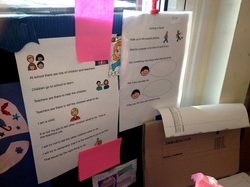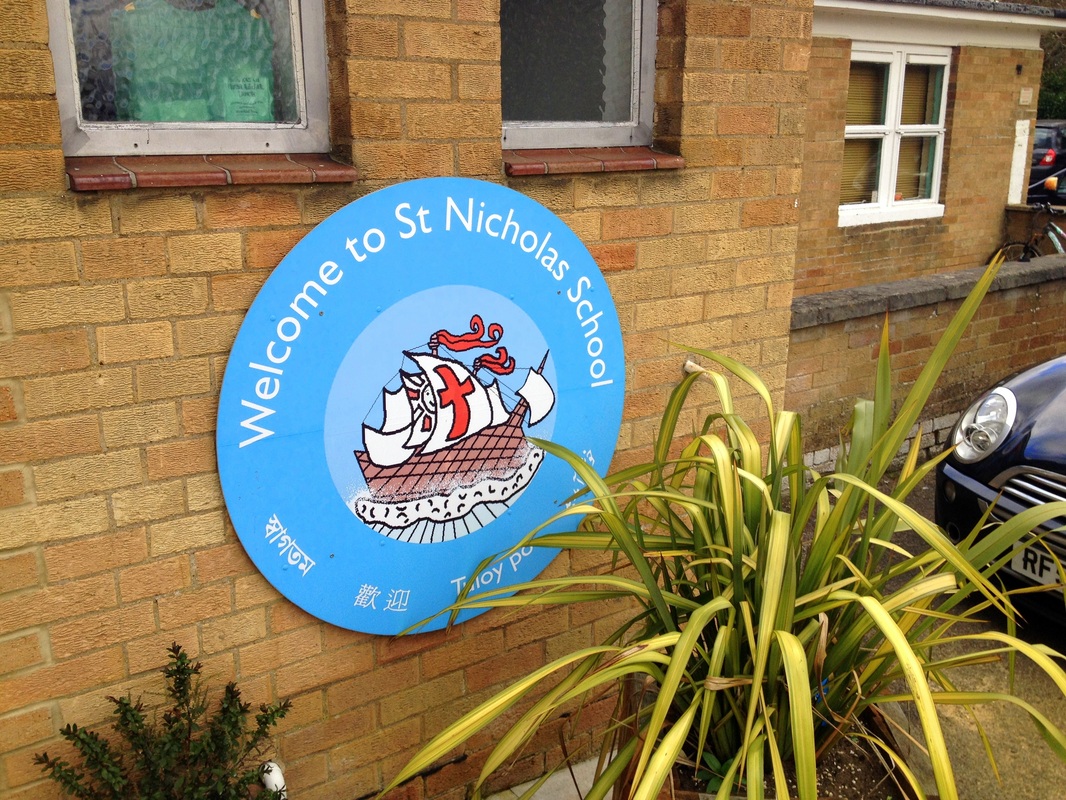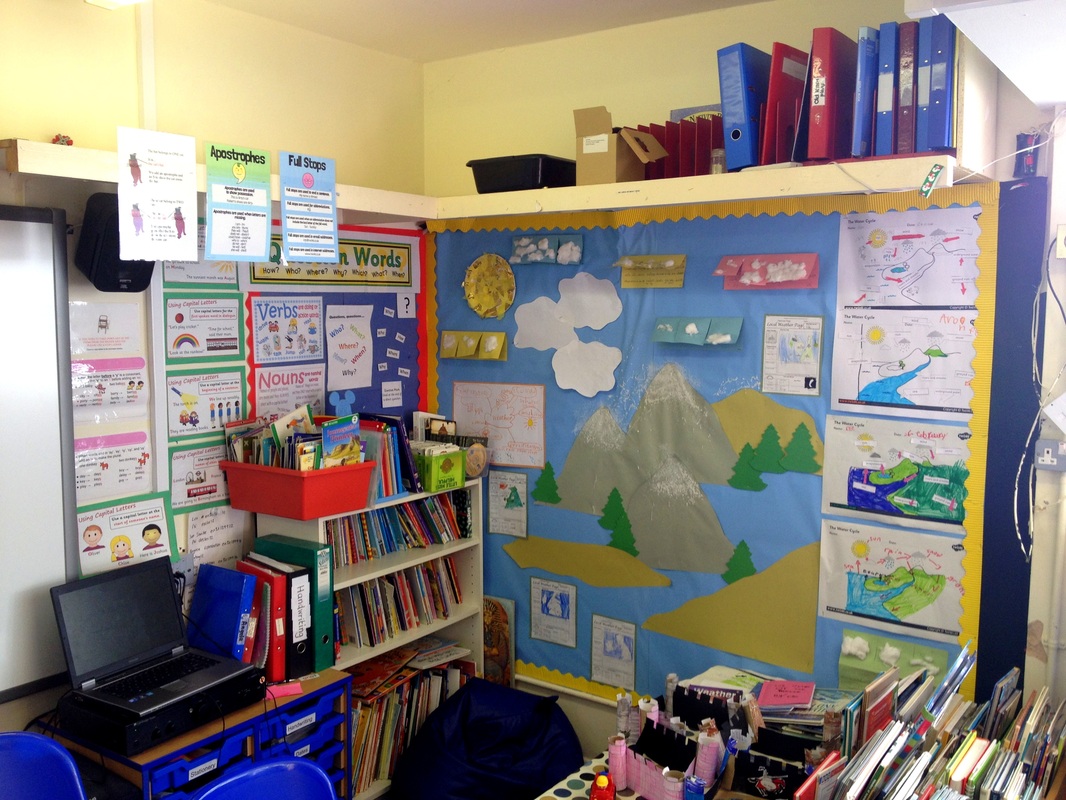Today I got to visit St. Nicholas Primary School in Oxford! I was shown around by my mum’s cousin (my first cousin once removed) Harriet who I last saw when her family came and visited New York City a few years ago. It was great to see her again and I am very grateful she arranged the visit to St. Nicholas.
| St. Nicholas Primary School (SNPS for the purposes of this post) is a co-educational community primary school (roughly ages 5 to 11) with no religious affiliation in the Oxford village of Marston. According to the Department for Education website, SNPS has 360 students with 13 of them receiving extra resources for “Autistic Spectrum Disorder” and “Speech, language and communication” issues. It was with this group of kids that I spent my day, observing the Communications and Integrations Resource Base (the CIRB or “the Base”) where they get small group or even one-on-one support away from the mainstream classrooms. Many of the adults who help out are volunteer Teacher Assistants (like Harriet) who come in once or several times a week. The students who learn in the CIRB are mostly kids with Autism, although they widely vary on the spectrum from those who are “high-functioning” with Asperger’s syndrome to those with severe Autism. The kids are split by age group, with 5-8 year olds on one side of the staircase and 8-11 year olds on the other. Some students split their time in the CIRB and mainstream classrooms, but many stay in the CIRB all day long. Let me tell you: there was a MASSIVE difference between the two groups as I got to spend time with both. I got to do a lot of different things throughout the day, met a lot of amazing people, and learned some very valuable things. After meeting Harriet at the bus stop, I checked into the school as a visitor and wound my way through what seemed to be a maze of hallways to the CIRB. All the kids start their academic school day at 0850, although there are some before-school clubs which meet in the mornings before school. |
When the Base’s kids first walk in (on the 8-11 side), they do some individual work and then move into a bigger group to work on handwriting skills (this includes OT hand-strengthening exercises and other activities to focus and quiet the group). They put up the day of the week (along with other things) on a Velcro board, then moved to a dance activity (which they do every Tuesday). At least one student joined the mainstream class at this time, but most of the students combined with the other side of the CIRB and went into the assembly hall. Here they did some physical exercise, dance routines, and following of simple directions: the kids seemed to have a great time. Next was music with rhythm, memory, and singing games and songs. Some of the kids got very involved with the activities and looked like they were enjoying them! When the groups broke up again, I stayed with the younger kids and saw math and counting practice along with a size comparison activity. Then came lunch, break, and play time (students had an 30 min for lunch and 30 min for recess), at which point I moved back to the older group to observe and participate in silent independent reading, stations, board games and “choosing time” (kids get to pick their own activity). Finally, students were dismissed at 1450 (mainstream students left at 1515).

One of the more interesting things I got to see was the station time the older kids did towards the end of the day. Essentially they were puzzles or activities meant to challenge them, like “build a copy of this out of blocks” or “draw the mirror image of this design.” There was very little if any verbal instruction from the adults and it was fascinating because I could actually see their minds working as they solved the problems given to them. The board game time was also a valuable part of the day as the adults worked on social skills like being gracious winners and not getting too “bent out of shape” after a loss. There seemed to be a focus on social skills, which is extremely valuable for kids with Autism, and they made a point to go over how to behave in certain situations.
After the students had left for the day, I asked the adults some questions about their school and the system as a whole. The biggest thing they said needed to be improved was that the government and schools needed to begin treating students as individuals. For example, it would be unreasonable to require that students must pass English and math to leave school, since for many special education kids that is an unattainable goal. The adults also said that SNPS was very good at providing creative outlets for the kids and that often the school observes a week-long theme (this week was “Science Week”). Students also have the opportunity to participate in many extra-curricular activities, as well as having a fair amount of the day put aside for physical activity. Specifically, the kids in the Base went swimming once a week and horseback riding every 3 weeks, along with practicing dance routines and break times.
After the students had left for the day, I asked the adults some questions about their school and the system as a whole. The biggest thing they said needed to be improved was that the government and schools needed to begin treating students as individuals. For example, it would be unreasonable to require that students must pass English and math to leave school, since for many special education kids that is an unattainable goal. The adults also said that SNPS was very good at providing creative outlets for the kids and that often the school observes a week-long theme (this week was “Science Week”). Students also have the opportunity to participate in many extra-curricular activities, as well as having a fair amount of the day put aside for physical activity. Specifically, the kids in the Base went swimming once a week and horseback riding every 3 weeks, along with practicing dance routines and break times.
| There also seemed to be a great music program from what I saw, and the teachers agreed that their school was very supportive of the arts. The mainstream and the CIRB’s students put on a whole host of concerts/talent shows for the school’s governors and parents, where kids play the piano, sing songs, and dance routines. Apparently there’s also at least one music assembly a week, and the music teacher gets everyone clapping and singing along. The TAs also told me about the school’s choirs and musical groups, including an orchestra with parent volunteers as teachers and participants! While the school has a great commitment to creativity, they did say that the arts were unfortunately almost always the first things cut when money was tight (which seems to be a universal problem, at least in the UK and the US!). | |
Overall I met some great teachers and assistants, whose patience and caring were boundless. I really did learn a great deal and I had a blast while doing it. I want to thank Harriet for arranging the opportunity, as well as the staff and administration of St. Nicholas Primary School for welcoming me into their wonderful school!!!




 RSS Feed
RSS Feed
